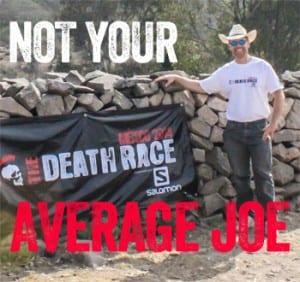
By: Tony Matesi
“Watch out!” a Death Racer shouted as the snarling bull charged across the ring slamming a racer against the wall. He was pinned to the ground if only but for a moment, the dust began to settle. Blood dripped from the bulls nostrils, not from a racer but from ramming it’s own face into the wall just missing it’s target. All across the arena crimson red bibs lay scattered about waiting to be collected by their owner.
Up till now, the Death Race was an abstract concept, each racer asking themselves if they possessed the mental and physical strength to survive anywhere from 36 to 72 hours of punishment at the hands of the co-founder of Spartan Race. Now, as they all stood inside a bullfighting ring in an undisclosed location in Mexico, it became real. Entirely too real. Death was more than just a possibility.
Never in my life did I expect to find myself standing in a bullfighting ring, filming and distracting a bull from Death Racers alongside the Founder and CEO of Spartan Race, Joe De Sena. But that’s just what happened. No cell service, barely any internet access, stuck on a ranch in the middle of nowhere Mexico and there I was camera in hand filming my boss and the Death Racers inside a bullfighting ring. I put fourth my best effort not to be gored while evaluating what kind of man and brain behind Outside Magazine’s “Best Obstacle Race,” the Spartan Race and the book Spartan UP! really is.
I could also ask what kind of man does it take to run over 300 miles straight? What kind of man does it take to complete the Vermont 100, the Lake Placid Ironman and the Badwater Ultra all in one week? After spending three days shadowing Joe in Mexico, being chased by bulls, repelling down into a waterfall and trying to avoid drinking the water at all costs, I think I found my answer.
Being the mind behind the “Best Obstacle Race” is no easy task. As you’d imagine it takes a lot of hard work and dedication. It takes a man with a vision, a passion, and an unrelenting work ethic that rivals other great entrepreneurs such as Richard Branson, Elon Musk, Steve Jobs or even Bill Gates. Joe De Sena has been an entrepreneur since the age of eight getting his start with selling fireworks. So how did I find myself in Mexico shadowing one of my entrepreneurial idols? It’s been quite a ride, but it all started back sometime after completing my first obstacle race in 2009, writing a short story about finishing the Death Race in 2012, and starting my own Death Race training event.
As you can imagine, I’ve done a lot of research on the Death Race. I’ve competed in two Summer Death Races, provided social media coverage for Obstacle Racing Media at the 2013 Winter Death Race. At the 2013 Team Death Race, I helped lead one of the tasks and continued my work for the “Dark Side” helping with the Peak Races social media coverage in 2014 at the Winter Death Race and the first ever traveling Death Race in Mexico. I’ve researched everything from how it started, why this madness began, how it gave birth to Spartan Race, and so on. I won’t go into too much detail but will provide a quick overview. My research led me to this opportunity to observe how the man who started it all operates while he conducts a Death Race.
Back in 2005, Joe De Sena and Andy Weinberg were hosting their Peak Ultra event and decided to add a new category to the list, the Death Division. The event became what is now known as the Death Race. The two race directors knew they were on to something with this event. It challenged people to leave their comfort zones. The first Death Races lasted 24 hours before they began a trend of becoming longer with each passing year. As of recent the Death Race has lasted over 48 hours and as much as 72+ hours for some racers at Summer 2013. The Founders wanted to introduce more people to this “overcome all obstacles” mentality but there was no way a race of this magnitude would ever appeal to the masses. Joe and Andy knew that they would be onto something as long as they scaled the race down while still providing an incredible challenge. In 2009 the first Spartan Race was held and the rest is history…in the making.
So one must wonder how does a guy like Joe De Sena do all that he does? Is he human? Does he sleep? How many emails does he answer every day? These are the questions you start asking yourself if you hang around with him long enough. What this man has done in his lifetime already is nothing short of unbelievable. He’s been an entrepreneur since the ripe age of eight and hasn’t stopped since. Joe has successfully started many businesses including a pool cleaning business, the Original General Store and a few lodges in Pittsfield, VT, and of course the race that has ripped over a million people off the couch, the Spartan Race series. Oh, and on top of that, he walks the walk having ran over 50 Ultra marathons in his life. Joe has been quoted as saying marathons are “adorable.”
Joe is not just an extremely successful business man, but he’s also an outstanding family man. Somehow he manages to host Death Race in the US and Mexico, frequent Spartan HQ in Boston, and he spends his time with his four children and wife Courtney in Pittsfield, VT. He has found the perfect balance in life and always leads by example. Joe finds time for exercise, answers more emails than you receive in a month on a daily basis, and continues to grow a lifestyle company that rips millions of people off the couch, thrusting them into a new healthier and happier direction.
Joe lives what he preaches. In November, the day after the Spartan Race at Fenway Joe gave a presentation at TEDx Beacon Street on why the burpee is the greatest exercise. At the event, Joe challenged the world to take on 30 Burpees a Day for 30 Days. It became a movement that got people all around the world off the couch performing burpees every day. With the Spartan Race series over 60 million burpees were served out to racers in 2013. Spend enough time with Joe, and soon enough you’ll be doing burpees with him wherever you are. It would seem very unlikely that a day goes by without Joe subjecting himself to a set of burpees.
When you have a vision that involves making a positive change in the world, it takes a lot of guts and a global support network to pull off. Joe knows how to rally the troops; he’s created a movement that empowers people. It gives them something to work for. Joe encourages and supports his followers. Joe invites people who want to make a change in their life to make it happen. He provides those looking for a change with housing, food and a new perspective on life. It doesn’t get handed to them. They have to work hard for it. Just like Joe did. He leads by example and expects the same of everyone. That’s all it takes, and that’s all he’ll ever ask for, some good ol’ fashion hard work. That’s what it takes to succeed in life, and Joe has a way of showing people how to get it done.
Joe embodies all that he seeks to share with the world. That was no different when I found myself working alongside Joe in Mexico for the first Traveling Death Race. Within moments of arriving at the ranch where the race was being held I found myself carrying a large spool of rope with Joe. We had the option to use a gator to transport the nearly 200 lb. spool. That’s not the Joe way of doing things. That’s not the Spartan way. The first thing I noticed, which Joe was quick to point out, was how much of an effect the elevation had on us. At nearly 6,000 feet Joe admitted he felt some effects of the elevation change but noted that, over the course of the week, he adjusted to the elevation difference. Joe and I lugged that rope over a mile out across some fairly sketchy terrain. It didn’t even phase him, and I just did my best to keep up.
From the moment we arrived at the ranch Joe was in Death Race mode. We set up obstacles, he threw Miguel Medina (who thought he was there only to crew) unexpectedly into the race, put the other racers and their crew members into cattle cars on a truck. He then transported them to a bull ring and made them obtain their red bibs while a bull chased after them nearly goring some of the racers. Thankfully, no one was hurt. The entire time Joe remained calm, he expressed concern but didn’t skip a beat. He jumped into the center of the ring without hesitation. While it shouldn’t be that much of a surprise to see Joe getting in on the action, it is a bit, as he put it, “insane” to have a bull chasing people around.
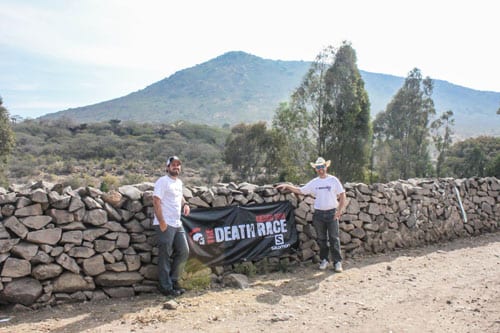
I learned that when you are on the Race Director side of things it can be almost as difficult if not more difficult than being the racer in a Death Race. As a racer you really only have to worry about doing what you are directed to in order to finish the race. When you are leading the race you are trying to coordinate challenges. You are evaluating all the risks that could happen. You are on a new landscape where rattlesnakes, black widows, and bulls are just a few of the dangers you may encounter. The entire time you have to be thinking on your toes regardless of how little sleep you’ve had. To be a Death Race – Race Director you have to constantly be on your A-game. There is no room for hesitation in the event a racer is injured. Often times, very seriously injured racers will insist on continuing to race. It’s ludicrous. They never want to hear that they have to stop, but it has to happen. As the race director you have to know where medical access is and is not available. You have to know whether or not a racer can safely continue and when it is too much of a risk. Joe makes these decisions quickly with full support from consultation of his staff. The racers best interests and safety are the primary concern.
Something I noticed while shadowing Joe during the race was how much he maximized the use of his time. He very often would walk places, allowing him time to plan and be active, rather than take a ride. Every time we stopped at the house on the ranch, Joe wold immediately check his emails. I found Joe crouched on the ground in a full squat with his Macbook Air right next to the router a few times. Efficiency, Joe is an expert at using his time effectively and efficiently. It’s one of those traits you want to learn from and can admire.
The unbelievable work ethic never seemed to even come to as much as a halt. Joe was relentless and up until sometime after 2:00AM. As it grew dark and the racers set off onto their second hike which would take an estimated four hours minimum, Joe laid down in a truck and radio’d me to wake him at 5:30AM. It was after 3:00AM already and my stomach began to rumble. The worst thing that could have happened in Mexico did. Food poisoning. Not from water, not from any crazy spicy Mexican food, no, it was a ham sandwich that sat out in the sun too long. I had to pass the responsibility on to someone else. My night would be distributed between visits to the bathroom and curled up in bed. The little time I spent in the bed came to an abrupt end from the sound of Joe radio’ing for someone to wake me immediately. Having heard the message myself, I jumped to life – stomach still in knots – and announced I was en-route. Joe had barely slept. Joe slept at most two or three hours during the Death Race. Again, this should not be surprising but how well Joe handles sleep deprivation is definitely noteworthy.
With Joe you quickly learn that down time is not actually down time. Joe is very passionate about what he does. He never stops trying to improve the race, he constantly searches for new ideas, new ways to motivate the racers. The race is a constant evolution and this iteration of the race was no different. An entirely new concept was introduced where a majority of the racers were required to finish otherwise everyone would suffer a DNF. In the Death Race the term majority meant 90% of the racers had to finish the race otherwise no one would finish. In addition to introducing a new paradigm shift in the mentality of what it takes to finish the Death Race he was already talking about the ideas for next years Mexico Death Race and the possibility of launching a new Traveling Death Race destination, mentioning Iceland as an option.
Joe has a very unique way of approaching life. He goes in head first. Always. It’s the only way he knows how to do anything. You can’t do something if you don’t go for it all the way. You could see this in how Joe was during the race. Nothing phased him and everything was always 100%. If something needed to happen it did. That’s just the way Joe does it and everyone loves him for it. At the end of the race, Joe was right there with everyone sharing stories and enjoying the home cooked authentic Mexican cuisine. The repeating feedback I heard was how thankful everyone was that Joe provides them the opportunity to participate in these events. The people that participate only inspire Joe to continue to grow this movement he’s unleashed on the world. It’s all about living life to the fullest and going in head first.
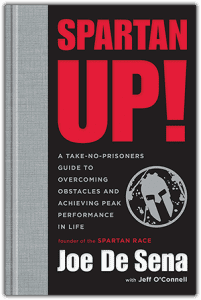 Take my word for it, Joe knows how to live life to the fullest. Everyone has the opportunity to life a fulfilling life. We just need to change our perspective we have to change our frame of reference. What has become the norm would make our ancestors turn in their graves. Joe’s new book Spartan UP! discusses how you can obtain obstacle immunity and begin living the life you want tell everyone about. Joe has a formula that works, it rips you off the couch, it pushes your mind and body beyond the limits and eventually grants you obstacle immunity. You cannot truly live unless death is more than just a possibility. Soon enough you’ll have a new perspective on the every day obstacles that challenge us leaving you with more opportunities to enjoy life, just like Joe.
Take my word for it, Joe knows how to live life to the fullest. Everyone has the opportunity to life a fulfilling life. We just need to change our perspective we have to change our frame of reference. What has become the norm would make our ancestors turn in their graves. Joe’s new book Spartan UP! discusses how you can obtain obstacle immunity and begin living the life you want tell everyone about. Joe has a formula that works, it rips you off the couch, it pushes your mind and body beyond the limits and eventually grants you obstacle immunity. You cannot truly live unless death is more than just a possibility. Soon enough you’ll have a new perspective on the every day obstacles that challenge us leaving you with more opportunities to enjoy life, just like Joe.
Editor's Note: Get a FREE limited edition Spartan Up! T-shirt designed by Joe De Sena when you pre-order Spartan UP! on Amazon and fill out the form here.
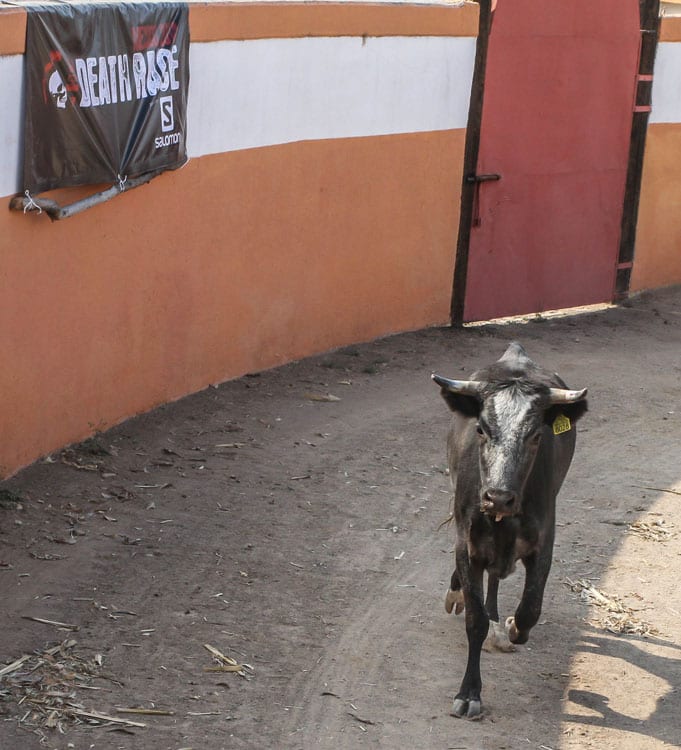
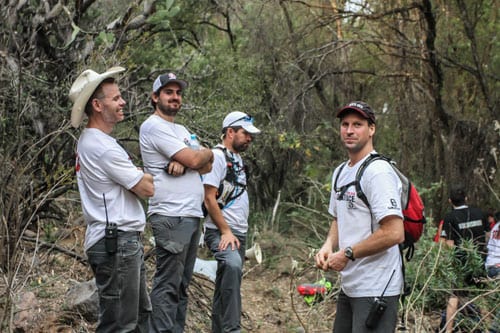


Leave A Comment